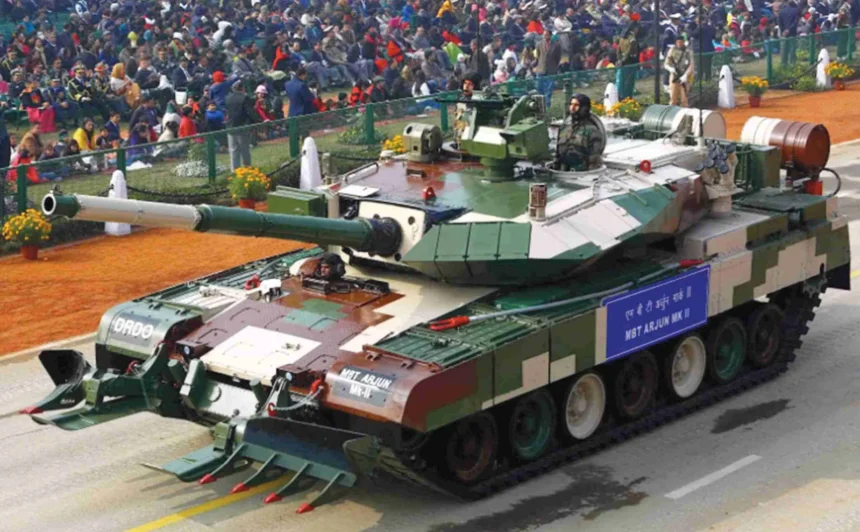Arjun Tank Programme’s Fate Uncertain Amid Engine Delays & Low Orders
Chandigarh: Fifty-one years after its inception in 1974, the Defence Research and Development Organisation’s (DRDO’s) Arjun Main Battle Tank (MBT) programme remains plagued by serious technological challenges, ballooning budgets and endlessly deferred production timelines.
Once hailed as the cornerstone of India’s indigenous armoured warfare capability, the hugely expensive Arjun venture continues to be criticised for its limited operational relevance and persistent shortcomings in mobility, maintainability, and deployability.
Consequently, the programme’s financially burdensome future remains uncertain, with the conceptual Future Ready Combat Vehicle (FRCV) – promising greater versatility and advanced technologies –increasingly gaining favour with the Indian Army (IA) and military planners.
Arjun’s latest setback
Arjun’s latest setback centres around its second batch of 118 upgraded Mk 1A variants – featuring 72 enhancements over the original 124 Mk1s-which were approved for induction into the IA by the Ministry of Defence (MoD) in 2021, for Rs. 7,532 crores. Deliveries of these retrofitted Mk1As were scheduled to commence in late 2024, with completion projected 3-4 years later.
But that timetable now stands delayed by at least five years to 2029, with full completion likely pushed to 2033-34 or even beyond, as the German-origin MTU 838 Ka-501 1400 hp diesel engine on which the Arjun was configured decades ago, has ceased production-an eventuality the DRDO failed to anticipate.
Around the time the MoD cleared the order for the 118 Mk1As, MTU – acquired by the UK’s Rolls-Royce in 2014 – had reportedly already informed the DRDO that the Ka-501 was out of production, and reviving it for such a limited order, if feasible at all. could take 4-5 years. This development further threatened the chronically beleaguered Arjun programme, compelling the DRDO to scramble for a replacement powerplant.
And, despite its inexperience, limited technical depth, and past failures in designing military-grade engines, the DRDO invoked the MoD’s Atmanirbharta (self-reliance) mantra and settled on the under-development DATRAN 1,500 hp V12 diesel powerpack as its solution.
Launched perfunctorily in 2020 by the DRDO’s Combat Vehicles Research and Development Establishment (CVRDE), in collaboration with Bharat Earth Movers Limited (BEML) and private vendors, DATRAN was originally intended as the powerpack for the locally designed Future Ready Combat Vehicle (FRCV), planned as replacements for the IA’s fleet of some 2,400 Soviet-era T-72M1 MBTs, 2034-35 onwards.
Defence industry officials noted that integrating DATRAN with the Arjun Mk1A was driven entirely by necessity rather than strategy, as DRDO’s failure in assessing the Ka-501’s unavailability had forced it to repurpose the local powerpack, still at the prototype stage, merely to keep the 118 Mk1A MBT order afloat.
Should DRDO succeed with DATRAN, the Arjun MBT programme will stand as a monument to squandered time and resources – producing barely 242 tanks over more than five decades, split between 124 Mk1s and 118 Mk1As, before being eclipsed by the FRCV. In effect, it would have delivered little more than a brigade-sized fleet of heavy, maintenance-intensive MBTs, ill-suited to the diverse and demanding terrains of northern and
“It seems DRDO’s main aim now is to use the Arjun as a test bed for DATRAN, a costly departure from its original role as India’s indigenous MBT,” said Major General A P Singh (retired).
This only further underscored the MoD’s and DRDO’s failure in delivering a competent armoured platform, despite decades of effort and massive investment that could have been more gainfully spent elsewhere, added the former armoured corps officer.
An industry insider in Bangalore, speaking anonymously, concurred and bluntly stated that the DRDO no longer viewed the Arjun as a combat asset but merely as an ‘engine mule’ for testing DATRAN. “Operationally, this is not a contribution – it’s a quiet abandonment of the much tom-tomed Arjun project” he asserted.
‘Staggering’ scale of re-engineering required
The impact of a mid-life engine swap on an MBT – or any major military platform, for that matter –cannot be overstated; in many cases, it is virtually equivalent to designing an entirely new weapon system. Industry officials warned that the scale of re-engineering required, especially on a MBT like Arjun beset by numerous technological shortcomings, was nothing short of ‘staggering’.
Experts further noted that an MBT’s engine is far more than a replaceable component – it is the core around which the entire platform is structured, dictating mobility, power output, weight distribution, hull design, transmission layout, cooling systems, and even external dimensions.
These dimensions-height, width, and silhouette – were critical as they directly influenced battlefield visibility and vulnerability, and shaped the MBT’s eventual tactical deployment. A taller or wider tank, for instance, presented a larger target and risked compromised performance, while a smaller, narrower MBT, though harder to detect and more manoeuvrable, often sacrificed armour protection, firepower, or both.
Consequently, swapping the MTU Ka-501 engine with the DATRAN – larger, heavier, and delivering different power output – would doubtlessly upend Arjun’s design equilibrium. The DATRAN’s altered dimensions and weight distribution would also affect armour layout, crew ergonomics, and internal systems, forcing a cascade of technical overhauls.
The engine bay and hull would need to be redesigned, transmission replaced, cooling and thermal management upgraded, and electronics and diagnostics reconfigured – all to accommodate a powerpack that was never part of the tank’s original design.
Meanwhile, the DATRAN prototype had completed preliminary bench trials at BEML’s Mysuru facility last year, but was yet to be integrated with the Arjun Mk1A for the IA’s mandatory two-year field evaluations through 2027-28.
These trials were crucial to validate the interface between the new powerpack and the MBT’s drivetrain that encompassed its transmission, power-transfer assembly and track propulsion systems. Notably, adopting DATRAN would also entail replacing, or extensively re-engineering, the German-origin Renk HSWL 295 TM automatic transmission, originally optimised for the MTU, at substantial additional cost.
“Building a tank engine is one of the most complex engineering challenges, requiring seamless integration of power output, durability, thermal management, and electronic control,” noted the aforementioned defence industry official in Bangalore. DRDO’s limited expertise in this sphere, he added, triggered doubts over DATRAN’s battlefield performance, as any deficiency could cripple platform mobility, degrade operational effectiveness, and endanger the tank’s crew.
The challenges posed by DATRAN extend even further.
Integrating it would also demand costly retooling of the Heavy Vehicles Factory (HVF) Arjun assembly line at Avadi, on Chennai’s outskirts, and establishing a comprehensive maintenance, overhaul, and logistics infrastructure. This would include dedicated supply chains, specialised crew and technician training, and a full lifecycle support system for two separate engines: the MTU Ka-501 for the Mk1 and DATRAN for the Mk1A.
However, at 68.25 tonnes – some six tonnes heavier than the Mk1 due to additional explosive reactive armour, mine ploughs, and ancillary equipment – the Arjun Mk1A would be amongst the world’s heaviest MBTs, thereby limiting its deployment almost entirely to Rajasthan’s desert region rather than Punjab or other adjoining areas.
Future hangs in the balance
This was because its mobility would be constrained by the sizeable nominal ground pressure (NGP) it exerted, rendering it unsuitable for Punjab’s soft soil and fragile infrastructure, where the IA had previously fought decisive tank battles with the Pakistan Army in 1965 and 1971. And even though the Mk1A variant has been fitted with wider tracks, with an NPG of 0.85kg/cm sq so as to evenly distribute its weight, it still remained a problem with regard to easily traversing the area, IA sources said.
Besides, most, if not all, bridges and roads in the region were rated to support a 50-tonne load, some 12–18 tonnes less than what the Mk1 and Mk1A weighed. To overcome this handicap, a 2017 Parliamentary Standing Committee report had advised infrastructure upgrades across Punjab and north India to accommodate the Arjun, but acknowledged that doing so for a handful of these MBTs would be prohibitively expensive, and hence impractical.
Alongside, maintaining the two existing Mk1 regiments –43 and 75 Armoured Regiments, comprising 124 MBTs inducted between 2004 and 2010– has proven highly challenging due to the platforms’ heavy reliance on imported components.
According to a 2017 Comptroller and Auditor General’s (CAGs) report, 69% of the Mk1’s parts were imported-from Belgium, France, Germany, Israel, the UK, and other countries-and many of these suppliers had, over the past decades, shut shop. This had adversely impacted the Mk1s with a large number being inoperable for extended periods, as replacing imported components and sub-assembles had proven difficult, if not impossible.
Arjun’s transportation also posed problems, with its bulk and vastness restricting its transit to specially modified broad-gauge rail wagons or specially configured road transporters, both costly and scarce. The aforementioned 2017 CAG report noted that deploying a single regiment of 55-60 tanks required 16 additional three-ton vehicles and at least 50 extra personnel.
Financially too, the Mk1A was prohibitively expensive, projected at Rs 63.8 crore ($7.2 million) each–nearly double the Rs 37 crore per unit it was costed at in 2011. By contrast, Russian T-90S and T-72M1 MBTs which comprise the backbone of the IA’s armoured formations, cost $2–2.5 million and $1.5 million each, respectively. Even the 62-tonne German Leopard-2 costs $5.7 million, the 56-tonne French Leclerc $4 million, and the Israeli Merkava IV approximately $4.5 million.
“The Mk1A, like the Mk1, will not deliver the Army any operational flexibility,” said Maj Gen Singh. Reinforcing roads and bridges across Punjab or places like Ganganagar for its deployment is simply unworkable and at best it will remain an overweight “boutique tank,” suitable only for select desert pockets, where it does not need to be mindful of the terrain.
In conclusion, the Arjun Mk1A’s future hangs in the balance, entirely dependent on DRDO’s success in delivering a fully validated and integrated DATRAN engine. Any failure would leave the already 51-year-long programme stranded, rendering the fervently lauded MBT programme a cautionary tale of Atmanirbharta driven by political ambition, but undone by enduring technical shortcomings.
Also Read: Asia Cup Final 2025: Pakistan Coach Warns India With 72 Hours to Go Before Dubai Clash








